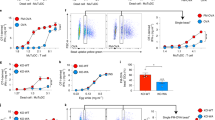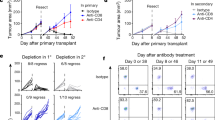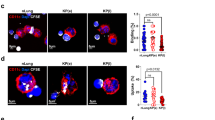Abstract
Injury or impaired clearance of apoptotic cells leads to the pathological accumulation of necrotic corpses, which induce an inflammatory response that initiates tissue repair1. In addition, antigens present in necrotic cells can sometimes provoke a specific immune response2,3,4 and it has been argued that necrosis could explain adaptive immunity in seemingly infection-free situations, such as after allograft transplantation or in spontaneous and therapy-induced tumour rejection5,6. In the mouse, the CD8α+ subset of dendritic cells phagocytoses dead cell remnants and cross-primes CD8+ T cells against cell-associated antigens7. Here we show that CD8α+ dendritic cells use CLEC9A (also known as DNGR-1), a recently-characterized C-type lectin8,9,10, to recognize a preformed signal that is exposed on necrotic cells. Loss or blockade of CLEC9A does not impair the uptake of necrotic cell material by CD8α+ dendritic cells, but specifically reduces cross-presentation of dead-cell-associated antigens in vitro and decreases the immunogenicity of necrotic cells in vivo. The function of CLEC9A requires a key tyrosine residue in its intracellular tail that allows the recruitment and activation of the tyrosine kinase SYK, which is also essential for cross-presentation of dead-cell-associated antigens. Thus, CLEC9A functions as a SYK-coupled C-type lectin receptor to mediate sensing of necrosis by the principal dendritic-cell subset involved in regulating cross-priming to cell-associated antigens.
This is a preview of subscription content, access via your institution
Access options
Subscribe to this journal
Receive 51 print issues and online access
$199.00 per year
only $3.90 per issue
Buy this article
- Purchase on Springer Link
- Instant access to full article PDF
Prices may be subject to local taxes which are calculated during checkout




Similar content being viewed by others
Change history
16 April 2009
A magnification value in Fig. 2 legend was corrected on 16 April 2009.
References
Rock, K. L. & Kono, H. The inflammatory response to cell death. Annu. Rev. Pathol. 3, 99–126 (2008)
Gallucci, S., Lolkema, M. & Matzinger, P. Natural adjuvants: endogenous activators of dendritic cells. Nature Med. 5, 1249–1255 (1999)
Shi, Y., Zheng, W. & Rock, K. L. Cell injury releases endogenous adjuvants that stimulate cytotoxic T cell responses. Proc. Natl Acad. Sci. USA 97, 14590–14595 (2000)
Sauter, B. et al. Consequences of cell death. Exposure to necrotic tumor cells, but not primary tissue cells or apoptotic cells, induces the maturation of immunostimulatory dendritic cells. J. Exp. Med. 191, 423–434 (2000)
Matzinger, P. Tolerance, danger, and the extended family. Annu. Rev. Immunol. 12, 991–1045 (1994)
Matzinger, P. The danger model: a renewed sense of self. Science 296, 301–305 (2002)
Villadangos, J. A. & Schnorrer, P. Intrinsic and cooperative antigen-presenting functions of dendritic-cell subsets in vivo . Nature Rev. Immunol. 7, 543–555 (2007)
Sancho, D. et al. Tumor therapy in mice via antigen targeting to a novel, DC-restricted C-type lectin. J. Clin. Invest. 118, 2098–2110 (2008)
Huysamen, C., Willment, J. A., Dennehy, K. M. & Brown, G. D. CLEC9A is a novel activation C-type lectin-like receptor expressed on BDCA3+ dendritic cells and a subset of monocytes. J. Biol. Chem. 283, 16693–16701 (2008)
Caminschi, I. et al. The dendritic cell subtype restricted C-type lectin Clec9A is a target for vaccine enhancement. Blood 112, 3264–3273 (2008)
Karttunen, J., Sanderson, S. & Shastri, N. Detection of rare antigen-presenting cells by the lacZ T-cell activation assay suggests an expression cloning strategy for T-cell antigens. Proc. Natl Acad. Sci. USA 89, 6020–6024 (1992)
Brown, G. D. & Gordon, S. Immune recognition. A new receptor for β-glucans. Nature 413, 36–37 (2001)
Naik, S. H. et al. Cutting edge: generation of splenic CD8+ and CD8- dendritic cell equivalents in Fms-like tyrosine kinase 3 ligand bone marrow cultures. J. Immunol. 174, 6592–6597 (2005)
Robinson, M. J., Sancho, D., Slack, E. C., LeibundGut-Landmann, S. & Reis e Sousa, C. Myeloid C-type lectins in innate immunity. Nature Immunol. 7, 1258–1265 (2006)
LeibundGut-Landmann, S., Osorio, F., Brown, G. D. & Reis e Sousa, C. Stimulation of dendritic cells via the dectin-1/Syk pathway allows priming of cytotoxic T-cell responses. Blood 112, 4971–4980 (2008)
Casares, N. et al. Caspase-dependent immunogenicity of doxorubicin-induced tumor cell death. J. Exp. Med. 202, 1691–1701 (2005)
Obeid, M. et al. Calreticulin exposure dictates the immunogenicity of cancer cell death. Nature Med. 13, 54–61 (2006)
Apetoh, L. et al. Toll-like receptor 4-dependent contribution of the immune system to anticancer chemotherapy and radiotherapy. Nature Med. 13, 1050–1059 (2007)
Mahnke, K. et al. The dendritic cell receptor for endocytosis, DEC-205, can recycle and enhance antigen presentation via major histocompatibility complex class II-positive lysosomal compartments. J. Cell Biol. 151, 673–684 (2000)
Burgdorf, S., Kautz, A., Böhnert, V., Knolle, P. A. & Kurts, C. Distinct pathways of antigen uptake and intracellular routing in CD4 and CD8 T cell activation. Science 316, 612–616 (2007)
LeibundGut-Landmann, S. et al. Syk- and CARD9-dependent coupling of innate immunity to the induction of T helper cells that produce interleukin 17. Nature Immunol. 8, 630–638 (2007)
Janssen, E. et al. Efficient T cell activation via a Toll-interleukin 1 receptor-independent pathway. Immunity 24, 787–799 (2006)
Kim, H. S. et al. Toll-like receptor 2 senses β-cell death and contributes to the initiation of autoimmune diabetes. Immunity 27, 321–333 (2007)
Cavassani, K. A. et al. TLR3 is an endogenous sensor of tissue necrosis during acute inflammatory events. J. Exp. Med. 205, 2609–2621 (2008)
Ziegenfuss, J. S. et al. Draper-dependent glial phagocytic activity is mediated by Src and Syk family kinase signalling. Nature 453, 935–939 (2008)
Yamasaki, S. et al. Mincle is an ITAM-coupled activating receptor that senses damaged cells. Nature Immunol. 9, 1179–1188 (2008)
Acknowledgements
This work was funded by Cancer Research UK. D.S. was supported by an EMBO long-term fellowship (ALTF 336-2004) and by a Marie Curie Intra-European Fellowship within the sixth European Community Framework Programme (MEIF-CT-2005-009205). We thank E. Schweighoffer and V. Tybulewicz for fetal liver from Syk-/- embryos. We also thank N. Shastri for B3Z and BWZ cell lines and A. Eddaoudi for assistance with cell sorting. We are grateful to members of the Immunobiology Laboratory, Cancer Research UK, for advice and discussions and the Biological Resources staff for animal care and assistance with mouse experiments.
Author Contributions D.S. and O.P.J. performed most of the experiments. A.M.K. performed the phospho-SYK staining and analysis of CLEC9A subcellular distribution. D.S., O.P.J. and C.R.S. planned the research, analysed and interpreted data and wrote the manuscript. N.C.R. helped with mouse breeding and genotyping. D.M. performed and analysed cell sorting and multispectral flow cytometry experiments. P.H.-F. generated SYK transfectants. I.R. contributed to the generation of CLEC9A-deficient mice.
Author information
Authors and Affiliations
Corresponding author
Supplementary information
Supplementary Information
This file contains Supplementary Methods and Supplementary References (PDF 368 kb)
Supplementary Figures
This file contains Supplementary Figures 1-10 with Legends (PDF 1415 kb)
Rights and permissions
About this article
Cite this article
Sancho, D., Joffre, O., Keller, A. et al. Identification of a dendritic cell receptor that couples sensing of necrosis to immunity. Nature 458, 899–903 (2009). https://doi.org/10.1038/nature07750
Received:
Revised:
Accepted:
Published:
Issue Date:
DOI: https://doi.org/10.1038/nature07750
This article is cited by
-
Dendritic cells as orchestrators of anticancer immunity and immunotherapy
Nature Reviews Clinical Oncology (2024)
-
Intratumoral Injection of Large Surface Area Microparticle Taxanes in Carcinomas Increases Immune Effector Cell Concentrations, Checkpoint Expression, and Synergy with Checkpoint Inhibitors: A Review of Preclinical and Clinical Studies
Oncology and Therapy (2024)
-
A necroptosis-related gene signature to predict prognosis and immune features in hepatocellular carcinoma
BMC Cancer (2023)
-
Dendritic cell subsets in cancer immunity and tumor antigen sensing
Cellular & Molecular Immunology (2023)
-
Role of dendritic cells in MYD88-mediated immune recognition and osteoinduction initiated by the implantation of biomaterials
International Journal of Oral Science (2023)
Comments
By submitting a comment you agree to abide by our Terms and Community Guidelines. If you find something abusive or that does not comply with our terms or guidelines please flag it as inappropriate.



